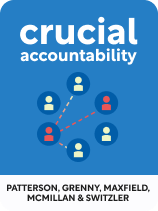

This article is an excerpt from the Shortform book guide to "Crucial Accountability" by Kerry Patterson, Joseph Grenny, et al.. Shortform has the world's best summaries and analyses of books you should be reading.
Like this article? Sign up for a free trial here .
Are any of your relationships strained because of an unresolved issue? Are you afraid that, if you address the issue, the relationship will be further damaged?
Accountability conversations are the discussions we have when someone breaks a promise, violates a commitment, behaves badly, or fails to meet our expectations. In Crucial Accountability, communication and management experts explain how we can have these conversations in a way that resolves the issues while preserving the relationships.
Read more for five accountability exercises that will help you implement the ideas in this universally relevant book.
Accountability Exercises
When we’re in a relationship with someone who has broken a promise, violated a commitment, behaved badly, or otherwise failed to meet our expectations, we’re forced to decide whether to bring up the issue and risk making our relationship worse or suffer in silence and let the issue continue. Luckily, communication and management experts Kerry Patterson, Joseph Grenny, David Maxfield, Ron McMillan, and Al Switzler explain that, if we properly prepare for, execute, and follow up on our accountability conversation, we can resolve our issues while improving our relationships.
We’ve put together five accountability exercises based on the concepts in the book. You can do these individually or with a group or team.
Exercise 1: Understand the Other Person’s Story
When someone breaks a promise or otherwise fails to meet our expectations, we’re quick to become angry and blame the other person’s character for their bad behavior. In reality, the other person might not have broken the promise because they don’t care about you, but because something was preventing them.
- Consider an accountability issue you’re currently dealing with. Think about how upset it makes you. Using these negative emotions as fuel, what are your immediate assumptions about why this person failed to meet your expectations?
- Now, imagine that the other person is the most honest, trustworthy, and upstanding person you know. Why might this amazing person have failed to meet your expectations? What personal, social, or structural factors might have impacted their motivation or ability to meet your expectations?
- Based on your last response, do you think your initial emotional assumption about the person’s behavior was fair or unfair? Does this change how you feel about the other person and the accountability issue? If so, how?
Exercise 2: Maintain Safety
Sometimes when we’re in the heat of a conversation, we miss signs that the other person might be feeling unsafe. This accountability exercise will help you learn to identify these signs and restore safety as quickly as possible in order to have an effective conversation.
- Think about an accountability conversation you’ve had in the past that ended badly because the conversation lacked safety—the other person felt attacked or uncomfortable. What behaviors was the other person exhibiting that hinted that they felt unsafe?
- Why do you think the other person felt unsafe? Was it due to a lack of mutual respect or a lack of mutual purpose? What indicators make you believe so?
- Now that you’ve identified why the other person felt unsafe, what strategy could you have used to reestablish safety? What would you have said?
Exercise 3: Handle Emergent Issues
When holding an accountability conversation, there’s always the possibility that a new and unexpected issue will arise. This accountability exercise will help you learn to identify the issue at hand and respond appropriately.
- Imagine that you’re having an accountability conversation with your coworker about them eating your food from the fridge. You lay out the facts, describe the gap between your expectations and what’s happening, and then invite the other person to share their story. When they respond, they inform you that it wasn’t them who ate your food, it was John. You know it wasn’t John because you saw John eating his own lunch. Your coworker is lying. How would you handle this situation?
- Now that you’ve considered how to handle the situation, imagine what you would say to this coworker.
Exercise 4: Identifying Your Bad Behaviors
During accountability conversations, there are a handful of common mistakes that people make which could negatively affect the outcome. Often, we don’t realize that we’re making these mistakes because they happen unconsciously. This accountability exercise will help you learn to identify what went wrong by looking at past failed conversations so you can avoid making the same mistake in the future.
- Think about the last time you had an accountability conversation that didn’t end well—for example, a sibling or partner blew off the agreed-upon solution or an employee became annoyed at you. Now consider the above mistakes. Did you do anything either consciously or unconsciously that caused the adverse consequences?
- Now that you’ve identified what you might have done that resulted in the unsatisfactory outcome, reflect on other exchanges you’ve had in the past (consider not only accountability conversations but other exchanges such as making a request of someone or giving them feedback). Have you repeated this behavior in other contexts? What was the other person’s response to the behavior and what was the outcome of the exchange?
- If you find that this is a repeated behavior that results in a negative outcome during exchanges with others, consider that it might exist in your blind spot. In other words, you might not realize that you’re doing it. Brainstorm some techniques or alternative behaviors that might help you avoid making the same mistakes in the future.
Exercise 5: Create a Plan
When you’ve finally finished the conversation, you must make a plan of action and set a time to follow up to ensure that commitments are followed through on. How you approach the follow-up, though, depends on the situation.
- Think of a recent accountability problem you’re having with an employee, coworker, or someone in your personal life. How has this person been failing to meet your expectations? For example, maybe you’ve noticed lately that a coworker, who usually does a great job, has been overlooking details and thus adding to your responsibilities, as you’re the one who then has to catch these details.
- What would your plan of action look like to solve the problem? Be sure to identify the who, what, and when of your plan.
- Now consider how you might follow up on your action plan. Think about the factors discussed above—how reliable and experienced is the other person? What is their track record on following through with commitments? How complicated is your request? Are there any deadlines involved?

———End of Preview———
Like what you just read? Read the rest of the world's best book summary and analysis of Kerry Patterson, Joseph Grenny, et al.'s "Crucial Accountability" at Shortform .
Here's what you'll find in our full Crucial Accountability summary :
- How to broach sensitive conversations with loved ones and coworkers
- How to prepare for, execute, and follow up on accountability conversations
- How to solve issues while improving your relationships






